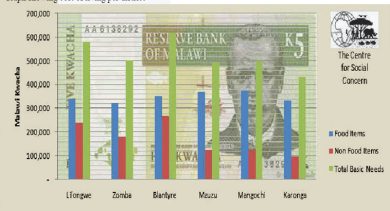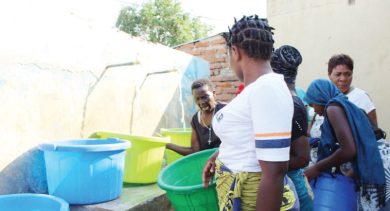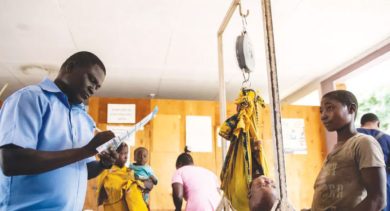Malnutrition surges as crop harvests fall
April marks the begining of the end of the hunger and malnutrition season in Malawi, but there was no time to rest for caregivers in Mangochi District.
“We didn’t expect patients to be admitted at this time, as it’s the harvesting period. Yet, this week we have a full ward,” said Peter Wonderford from Madalitso Nutrition Rehabilitation Unit.
As the clinician left for lunch, a woman arrived with a frail six-month-old baby boy.
The six-bed model nutrition clinic, situated along the southern shoreline of Lake Malawi receives malnourished children from Monkey Bay Community Hospital and its surrounding villages.
“A health surveillance assistant [HSA] referred me here. My sickly son is coughing persistently. He is weak and losing weight,” says Beatrice Charles, from Chirombo Village.

Wonderford measures baby Lauren’s weight, height and middle upper arm circumference (Muac).
“The Muac readings falls on red, meaning the baby has severe malnutrition,” he tells the mother.
She is not surprised.
“I cannot produce enough milk for the baby since I eat once a day. So, my baby cries all day. So, I introduced thin porridge to my baby, even though I know that health workers promote exclusive breast feeding in the first six months of baby’s life,” Beatrice states.
Due to the devastating floods and high fertiliser prices, her two-acre maize field produced just five bags in 2023. Her food basket ran dry two months before Lauren’s birth, leaving the family of eight living hand-to-mouth on meagre earnings from a bicycle taxi.
The clinician did a thorough clinical and nutrition assessment on Lauren and immediately enrolled him on an outpatient therapeutic programme – starting with a one-week ration of ready-to-use therapeutic food to take home.
He warned: “RUTF is medicine, so ensure the baby takes it without fail. Malnutrition doesn’t just threaten a child’s health, learning and chances in life, it kills.”
Mangochi district medical officer Dr Victor Kunfunda says: “We have seen a 40 per cent increase in malnutrition cases since 2023 and relapses have also risen. Patients who were treated and recovered are relapsing.”
He further said the country requires more than just food aid.
“This isn’t just a health issue; we need a multidisciplinary approach. We need support for health workers to intensify malnutrition prevention, surveillance and treatment. The Ministry of Agriculture needs to promote crop diversification and irrigation.
“Our social welfare colleagues should provide social protection to save the poorest from starving. The Ministry of Water and Sanitation should prevent diarrhoea and other sanitation-related infections that fuel malnutrition,” said Kunfunda.
Madalitso NRU has also noted an increase in the number of deaths as it recorded four deaths between January and March 2024 which is very unusual. In 2023, they only recorded 4 deaths for the whole year.
Unicef supports the Government of Malawi to combat malnutrition through capacity building of health workers, toolkits for nutrition screening, RUTF and therapeutic milk, as well as promoting positive child feeding practices and behaviours.
The country’s Southern Region faces prolonged food shortage due to drought caused by El Nino weather patterns which have affected the entire southern Africa.
Lengthy dry spells have almost halved maize production a year after Tropical Cyclone Freddy affected over 2.2 million people and washed away about 55000 hectares of planted farmlands in 13 districts. The loss represents about 27 percent of the crops Malawians planted in the 2022-23 rainy season, the Department of Disaster Management Affairs reports.
On March 24 2024, President Lazarus Chakwera declared a State of Disaster in 23 of the country’s 28 districts and appealed for K357.6 billion for about two million households affected by the harsh weather.
“From cyclones to drought and flooding caused by rains we haven’t seen, there’s no break for us. We need urgent help as children are wasting and stunting,” says group village head Mtondeza of Chikwawa District in the Shire Valley.






This piece was incredibly enlightening! The level of detail and clarity in the information provided was truly captivating. The extensive research and deep expertise evident in this article are truly impressive, greatly enhancing its overall quality. The insights offered at both the beginning and end were particularly striking, sparking numerous new ideas and questions for further exploration.The way complex topics were broken down into easily understandable segments was highly engaging. The logical flow of information kept me thoroughly engaged from start to finish, making it easy to immerse myself in the subject matter. Should there be any additional resources or further reading on this topic, I would love to explore them. The knowledge shared here has significantly broadened my understanding and ignited my curiosity for more. I felt compelled to express my appreciation immediately after reading due to the exceptional quality of this article. Your dedication to crafting such outstanding content is highly appreciated, and I eagerly await future updates. Please continue with your excellent work—I will definitely be returning for more insights. Thank you for your unwavering commitment to sharing your expertise and for greatly enriching our understanding of this subject.
Hot girls are waiting for you on —– https://u.to/sYM6IA
joint pain supplement glucosamine
knee joint feels loose no pain
pain in index finger between knuckle and joint
http://jointpain.top/ – joint pain weak immune system dependency on cortisol muscle pain
http://jointpain.top/ – joint and calf pain
http://jointpain.top/ – cialis causes joint pain
http://jointpain.top/ – what can you take for hip joint pain
http://jointpain.top/ – joint pain and sleep eatable majauna
pin up casino https://azerbaijancuisine.com/# pin up apk yukle
pin-up 306
mexican border pharmacies shipping to usa mexican pharmacy online buying from online mexican pharmacy
mexican pharmaceuticals online Mexico pharmacy that ship to usa buying prescription drugs in mexico online
buying prescription drugs in mexico online Mexico pharmacy that ship to usa mexican rx online
mexican pharmaceuticals online: mexico pharmacies prescription drugs – п»їbest mexican online pharmacies
mexican pharmaceuticals online mexican pharmacy mexican drugstore online
http://northern-doctors.org/# buying prescription drugs in mexico
https://northern-doctors.org/# mexican rx online
mexican online pharmacies prescription drugs: Mexico pharmacy that ship to usa – п»їbest mexican online pharmacies
mexican drugstore online Mexico pharmacy that ship to usa buying prescription drugs in mexico
http://northern-doctors.org/# mexico pharmacies prescription drugs
buying from online mexican pharmacy: northern doctors – mexican rx online
https://northern-doctors.org/# medicine in mexico pharmacies
buying prescription drugs in mexico online: Mexico pharmacy that ship to usa – best online pharmacies in mexico
mexico pharmacies prescription drugs: Mexico pharmacy that ship to usa – buying prescription drugs in mexico online
mexico drug stores pharmacies: mexican pharmacy northern doctors – mexico pharmacy
http://northern-doctors.org/# mexico drug stores pharmacies
mexico pharmacies prescription drugs Mexico pharmacy that ship to usa mexican online pharmacies prescription drugs
http://northern-doctors.org/# п»їbest mexican online pharmacies
mexican border pharmacies shipping to usa mexican online pharmacy mexico drug stores pharmacies
https://cmqpharma.online/# mexican pharmaceuticals online
mexico pharmacies prescription drugs
mexican rx online п»їbest mexican online pharmacies mexican online pharmacies prescription drugs
mexican rx online cmq mexican pharmacy online mexican mail order pharmacies